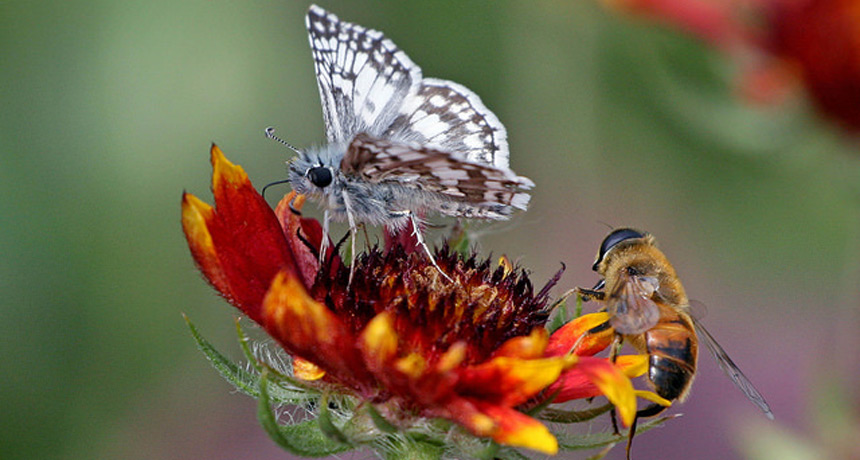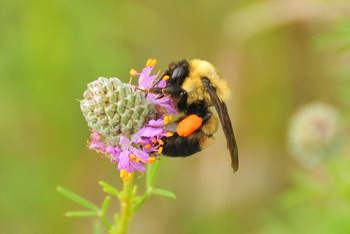Non-scents: Pollution can confuse pollinators’ sniffers
Air pollution makes it harder for insects to find the food they’re after

Two pollinators — a common checkered skipper butterfly and a bee — share a flower.
Gary Eslinger/USFWS/Flickr (CC BY 2.0)
Bees and other pollinators use scents to track down fresh flowers. Air pollutants can weaken or even scramble those scents. Scientists had worried that this might make it harder for some pollinators to find a meal. And indeed, a new study concludes, in some cases it could quadruple the pollinators’ effort.
Many animals help pollinate plants. They do this by bringing grains of pollen from one plant’s male parts to the female parts of another plant. Species that do this include bees, butterflies, moths and beetles. But for many reasons, the pollinators available to help plants in this way have been declining. Scientists think that a loss of habitat — good places to live — could be one factor. Diseases, parasites and exposure to certain pesticides also may be playing some role.
Jose Fuentes points to air pollution as yet another possible factor. He’s an atmospheric scientist at Pennsylvania State University in University Park. In an earlier study, he showed that some air pollutants could weaken or destroy scents given off by flowers. If the pollinators can’t smell the blooms, they may have to bumble around longer searching for lunch.
Foraging for a meal leaves pollinators out in the open and at risk of becoming some other animal’s lunch. And any time spent hunting food is time away from their duties back home, such as protecting a hive or nest, explains T’ai Roulston. He is an insect biologist at the University of Virginia in Charlottesville. Roulston worked with Fuentes on the new study.
The team decided to probe how pollution might affect the lunch break bees would take from a hive. The group used a computer to model scent changes in response to various polluting chemicals in the air. Their data now indicate bees and other insects could take longer — much longer — to find and follow scents to a meal. The scientists have just shared their findings in the July 1 issue of Atmospheric Environment.
What the computer predicted
Flowering plants emit gases that perfume the air. The fragrant molecules disperse and create a scented plume. Like a game of hot and cold, pollinators use their antennae to follow the gradient, always looking for where the scent strengthens. A strong scent means they are closing in on a bloom. A weaker scent means they’re drifting off course.

The researchers focused on five representative floral scent molecules. One molecule they looked at, for example, is called beta-myrcene (BAY-tuh MER-seen). A number of blooms emit this chemical into the air. Among them: snapdragons, purple coneflower, parsley, hops and certain citrus plants. Normally, this gas can travel some 800 meters (0.5 miles) from its flower source. But in polluted air, this same molecule could travel only half as far. Changes to beta-myrcene and other scent molecules as they interacted with the pollutants meant that insects would have to spend longer in search of a meal.
About 50 percent of foraging insects can sniff out a particular scented plume in 15 minutes if the air was clean. But the same insects could take an hour, the computer predicts, to find the scent plume when air is moderately polluted with ozone. Ozone is one of the primary irritants in urban smog. And the level of ozone considered here would be typical for a major U.S. city on a hot summer day, notes Fuentes.
These findings give scientists clues about what may be going on in nature, says James Blande. He is a chemical ecologist at the University of Eastern Finland in northern Europe. He wasn’t involved with this research. Still, he says, “it’s important to test these assumptions in real world experiments before drawing any firm conclusions.”
But air pollution might do more than just weaken scent plumes. Chemical reactions between air pollutants and plumes may transform the blooms’ fragrances, creating new scents. And these scents may be unrecognizable to pollinators.
That’s certainly Fuentes’ concern. So, he says his next research project will be to look at how insects deal with any new floral scent. “It is possible that some insects will evolve ways to detect and use these new molecules to find food,” he says.







